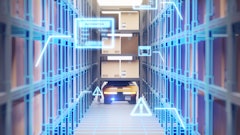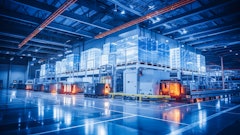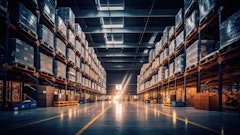
Amidst the evolving market landscape, companies are turning inward to find ways to streamline their operations and safeguard their profit margins. Warehouse operations are both labor-intensive and time-consuming, making them ripe for scrutiny when leadership seeks opportunities to improve. The good news? It is also an area that is well suited to automation and advanced technology solutions, notably AI (artificial intelligence), with big potential gains and savings when the right strategies are employed.
Through automation and the use of AI, warehouse operations can reach new heights in productivity and profitability. Tasks such as freight handling and inventory management can be streamlined and optimized for better speed and accuracy. Digital solutions can reduce the impact of human error and help companies mitigate the ongoing challenge of filling vacant warehouse positions.
Today, meeting consumer demand and expectations for fast, timely service is a competitive necessity brought on by the growth in e-commerce and the demand for expedited fulfillment. Plus, in this day of supply chain disruptions, risk and changing consumer expectations, swift and accurate logistics decision-making is imperative. AI warehouse solutions offer the ability to perform tasks faster with more precision and to automate a broad range of warehouse processes.
Prerequisites to AI
AI, despite all its thrilling and grandiose potential, is not a silver bullet. It requires a solid foundation of people, processes, and existing technology to have the greatest positive impact. AI combined with the experience and knowledge of logistics professionals, along with the data in warehouse management systems, is the recipe for increased productivity. The combination can effectively unlock data-based demand forecasting, re-stocking and predictive equipment maintenance, just a few examples of advances unheard of in years past.
The Role of Data
To effectively implement AI systems in a warehouse, large volumes of relevant and high-quality data are required to train models, make accurate predictions, and ultimately optimize warehouse processes. Warehouse management systems are a fundamental component, feeding AI models with essential data such as inventory levels, order history, shipment data, equipment status and more.
The quality of operational logistics data, its accuracy and completeness, is critical for the success of AI warehousing implementations. Quality data sets enable AI algorithms to make reliable predictions and recommendations. Inaccurate or incomplete data can lead to flawed insights and suboptimal decision-making. A company’s warehouse data may be housed in various systems including Enterprise Resource Planning (ERP), Warehouse Management System (WMS) and other databases. Integration of these systems helps ensure a seamless, effective data flow to achieve a comprehensive and reliable dataset for AI warehouse applications.
Human-in-the-Loop AI
The role of humans as an important component of AI digital transformation cannot be understated. People play a key role in overseeing, guiding and validating the outputs of AI systems. By combining the power of human expertise with artificial intelligence, logistics providers can truly revolutionize warehouse operations and unlock new opportunities.
This human role augmenting the artificial intelligence technology is known as human-in-the-loop AI. Humans provide critical input, vision, domain knowledge and contextual understanding that AI algorithms may lack. The aim is to enhance not only the reliability but also the relevance of AI-generated results.
Intelligent Demand Forecasting
One area that can be costly for a business is excess inventory. Changing market demand and supply chain challenges can be disruptive and negatively impact the bottom line. AI can contribute to better demand forecasting and automated reordering which allows for leaner and more accurate purchasing and inventory decisions, coupled with improved logistics operations.
In demand forecasting, AI algorithms offer a powerful tool for analyzing historical data, market trends, and various pertinent factors to predict future demand accurately. By leveraging this predictive capability, warehouse managers can optimize inventory levels, mitigating the risks associated with both overstocks and stockouts. The ability to align stock levels with actual demand not only improves resource allocation but also enhances customer satisfaction through timely order fulfillment.
Additionally, AI systems can be configured to automatically initiate restocking orders once inventory levels hit a predefined threshold. This automated approach minimizes the likelihood of stockouts, contributing to a more streamlined supply chain and allowing warehouse personnel to focus on higher-value tasks. Implementing AI in these areas empowers warehouse managers with data-driven insights and automated processes, ultimately leading to improved operational efficiency and a more resilient inventory management system.
Intelligent Cargo Measurement
The measurement and weighing of palletized cargo and packages are a particularly error-prone process. It is also time-consuming and can be costly if inaccurate measurements result in ongoing chargebacks. Being off as little as a quarter inch on a regular basis can truly impact a company’s bottom line when it’s multiplied over thousands of shipments.
The next generation of package measurement automation is faster, reducing friction by capturing even more shipment information using intelligent technology, AI and OCR (optical character recognition). OCR is a technology that uses machine learning algorithms to recognize and extract text from images for effective data capture automation. For example, gleaning important address data from a shipping label.
By combining AI and OCR technologies, the measurement and weighing of cargo and transcribing of label data can be accomplished in seconds. Manual data entry is no longer necessary. Add a powered conveyor belt and in-motion scale for a completely automated experience that is extremely efficient and fast. It can be fully integrated with logistics providers’ or shippers’ warehouse systems to further streamline freight, package and pallet handling and speed processing.
In recent years, an unprecedented level of supply chain disruption has shippers keenly focused on incorporating supply chain resilience into their planning. The need to achieve supply chain agility, flexibility and productivity in warehousing and distribution, as well as in all supply chain links is a priority. This need has put automation front and center due to its ability to transform and advance logistics operations.
Simplifying time-consuming, labor-intensive warehouse processes with automation and AI offers a faster, more accurate, and intelligent operational foundation that improves productivity and bottom-line results. This creates a significantly better experience for employees, companies and their customers.

























